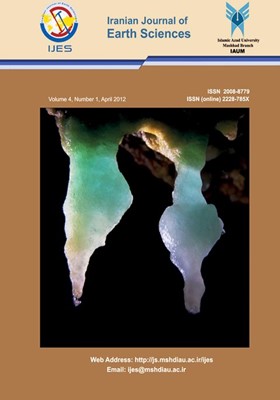Apatite Application to Investigate Magmatic Evolution of Zouzan Granites, NE Lut Block
محورهای موضوعی : MineralogyS.A. Mazhari 1 , R. Sharifiyan Attar 2
1 - Department of Geology, Payame Noor University, 19395-4697 Tehran, Iran.
2 - Department of Geology, Payame Noor University, 19395-4697 Tehran, Iran.
کلید واژه: trace elements, Apatite, Granite, I-type, S-type, Zouzan pluton,
چکیده مقاله :
Apatite minerals of I-type Zouzan granitoids and typical garnet-bearing S-type granites have been analyzed by electron microprobe to define trace element concentrations and compare them in different granites. Zouzan granites are composed of apatites with lower Fe, Mn, Na and HREE and higher REE and ∑REE relative to S-type ones. Trace elements abundances of apatite often vary with some parameters of the host rock, especially aluminum saturation index (ASI). Strontium content of apatite is very sensitive to whole-rock composition and binary diagrams of SrO- trace elements could be used to discriminate different granites and realize magmatic evolution in a single phase. The apatite concentration of Fe, Mn, Na and HREE increases during magmatic fractionation in Zouzan pluton, while Sr and REE decreases. The difference of REE concentrations in apatites of mafic and felsic rocks of Zouzan granitoids relates to the coeval or earlier crystallization of amphibole and titanite, respectively. Acicular apatites which are present in granodiorites and mafic microgranular enclaves show exceptionally dissimilar composition in comparison with other apatites in the same sample and host rock geochemistry. Extraordinary high levels of Fe, Mn, LREE, (Sr apatite /Sr bulk-rock )>1 and unusual low HREE indicate that a more mafic magma was involved in magma genesis of Zouzan pluton and confirms magma mixing
Apatite minerals of I-type Zouzan granitoids and typical garnet-bearing S-type granites have been analyzed by electron microprobe to define trace element concentrations and compare them in different granites. Zouzan granites are composed of apatites with lower Fe, Mn, Na and HREE and higher REE and ∑REE relative to S-type ones. Trace elements abundances of apatite often vary with some parameters of the host rock, especially aluminum saturation index (ASI). Strontium content of apatite is very sensitive to whole-rock composition and binary diagrams of SrO- trace elements could be used to discriminate different granites and realize magmatic evolution in a single phase. The apatite concentration of Fe, Mn, Na and HREE increases during magmatic fractionation in Zouzan pluton, while Sr and REE decreases. The difference of REE concentrations in apatites of mafic and felsic rocks of Zouzan granitoids relates to the coeval or earlier crystallization of amphibole and titanite, respectively. Acicular apatites which are present in granodiorites and mafic microgranular enclaves show exceptionally dissimilar composition in comparison with other apatites in the same sample and host rock geochemistry. Extraordinary high levels of Fe, Mn, LREE, (Sr apatite /Sr bulk-rock )>1 and unusual low HREE indicate that a more mafic magma was involved in magma genesis of Zouzan pluton and confirms magma mixing


